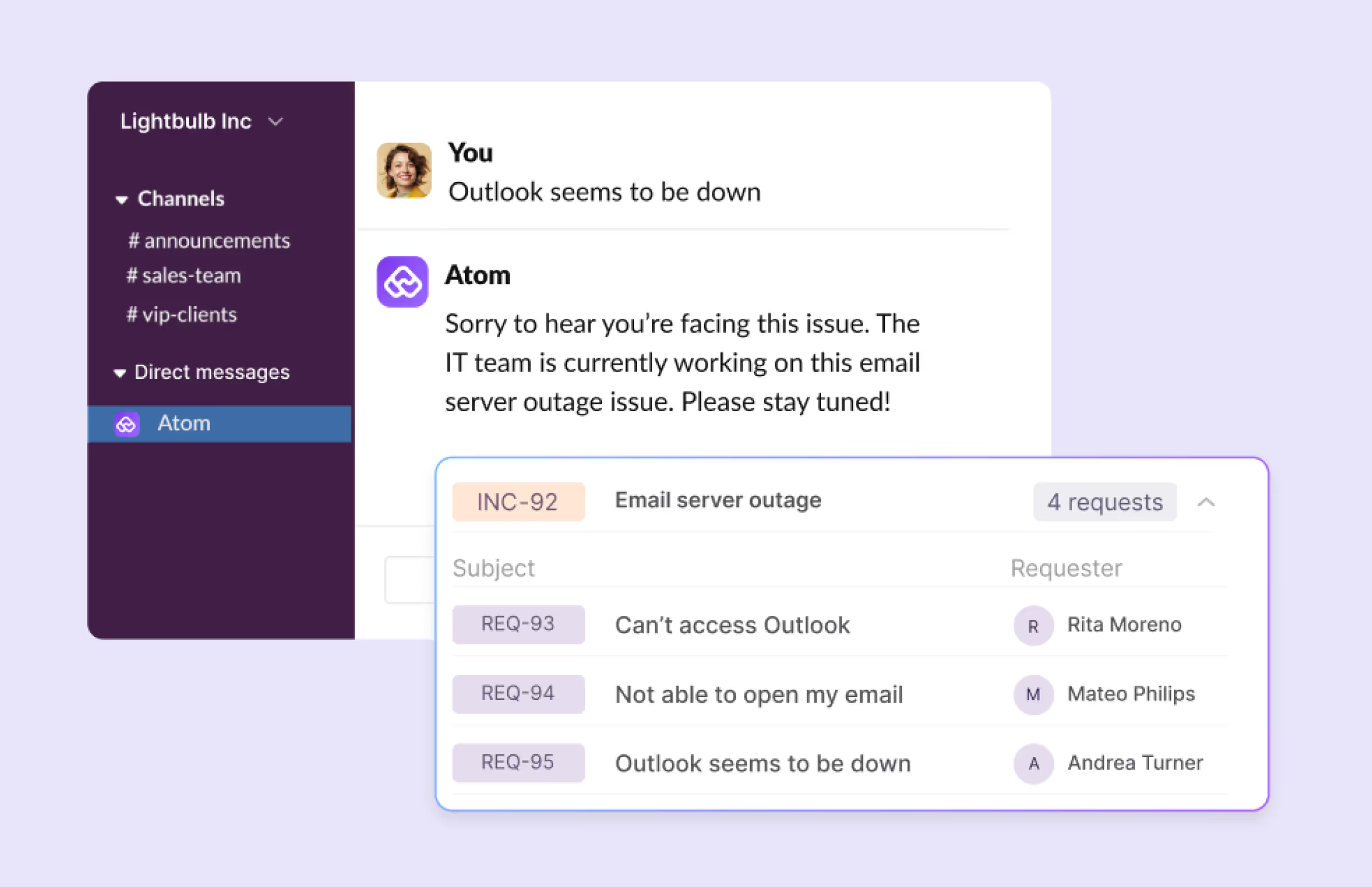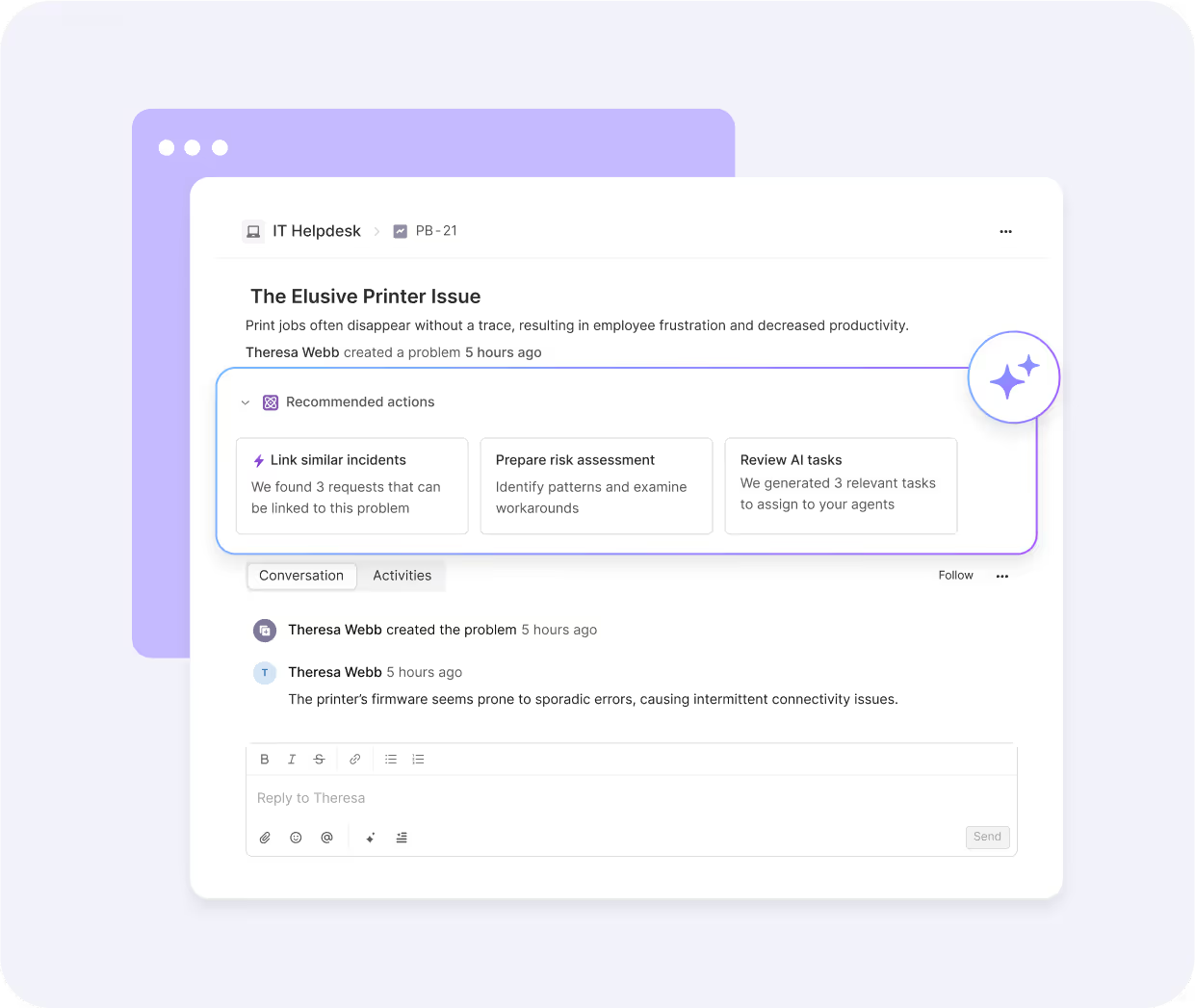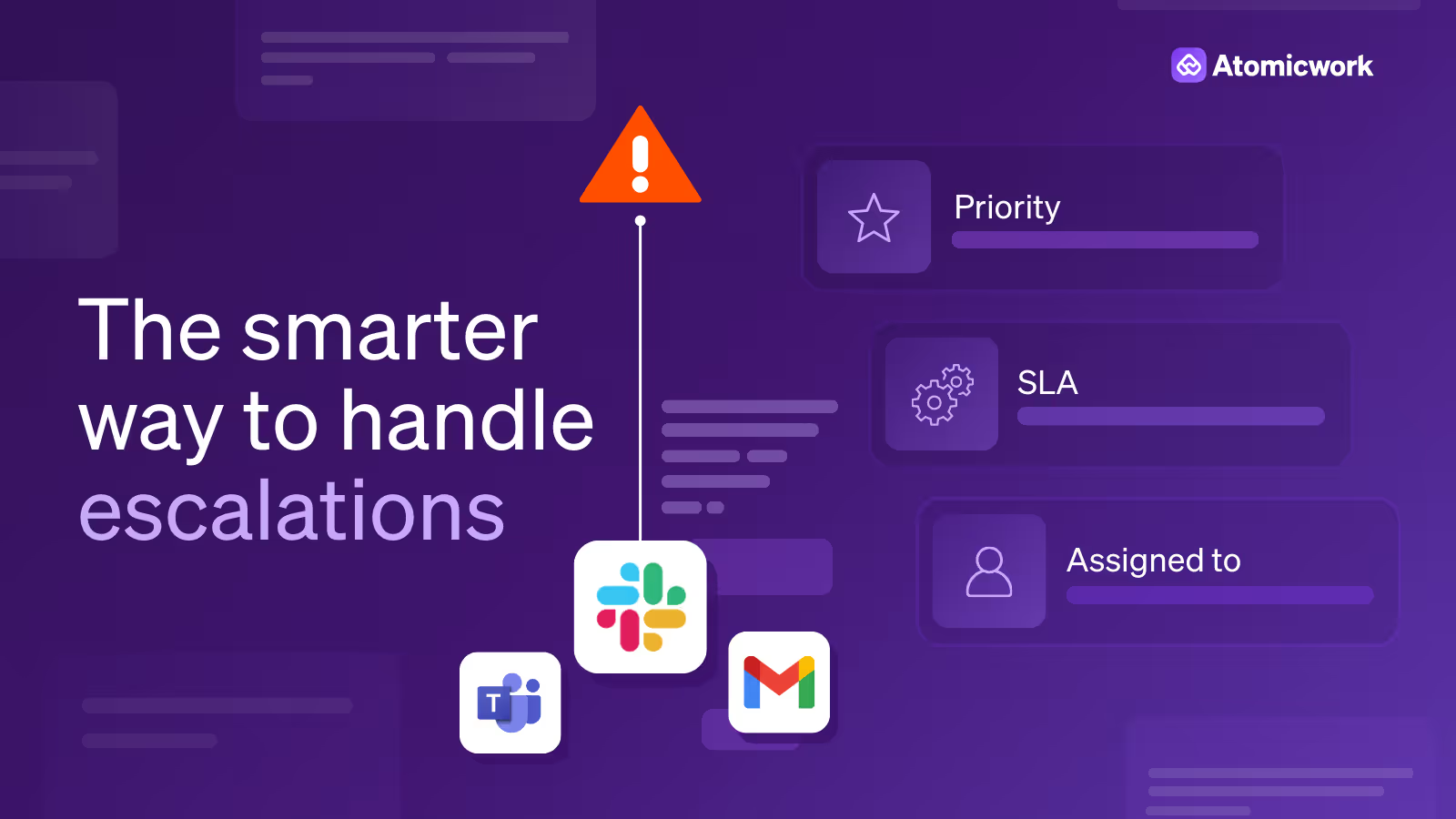Incident vs. Problem Management: Why Modern IT Teams need both

A single hour of downtime now costs large enterprises an average of $300,000, as per ITIC consulting. For IT teams, that's more than just a number. It's the pressure to keep systems running and users productive every single day.
Most enterprises have solid incident management processes to handle disruptions when they happen. But here's what often gets missed: without rigorous problem management, you're stuck fixing the same issues over and over. Modern IT teams need both and we’ll show you in this article why it matters to have separate incident and problem management processes.
But basics first:
Incident management is the process of restoring IT services quickly after an unplanned disruption. It focuses on minimizing downtime and getting users back to work.
Problem management identifies and fixes the root causes behind recurring incidents. It's about preventing issues from happening again.
TL; DR - Incident management swiftly resolves disruptions, ensuring smooth IT operations. On the other hand, problem management focuses on preventing recurring issues, improving system performance and reliability.
Before we dive in, let’s first understand how an incident differs from a problem.
Incident vs. problem vs. change: Explained with an example
As per ITIL (Information Technology Infrastructure Library), an incident is an unplanned disruption to service or the failure of a service component. A problem is the underlying cause or root of one or more incidents. Finally, a change is anything that is added, removed, and modified in a service that has a service impact.
Let’s take an example of a recurring printer issue.
Imagine your IT support team starts getting a couple of incidents from their HR team that the printer isn’t working properly.
- Your IT technician begins resolving each of these incidents separately.
- The following week, a few other HR team members report incidents with the same printer. The technician now notices that it's a recurring issue and reports it to his manager.
- The manager and team review the incident history. They confirm the pattern of frequently jamming printers in the HR department.
- They open a problem ticket to identify the root cause. They ask the support technician to inspect the printer and pull up maintenance records.
- On further troubleshooting, they determine that the printer is reaching the end of its lifespan and has to be replaced.
- The manager creates a plan to procure a new printer, migrate users, and update the knowledge base to prevent future incidents.

By addressing the underlying problem, the IT team is able to provide a more reliable printing solution and avoid repeated service disruptions.
Think of it this way: Problems usually stem from incidents and can result in a change.
So should you add Problems to your IT team?
As ironic as it sounds, yes. In fact, as seen from the above example, analyzing and tracking repetitive incidents as a ‘problem’ sets up your IT team for minimal disruptions in the future.
Aparna Chugh, Head of Product at Atomicwork, explains it this way: 'In today's fast-paced IT environments, every issue - no matter where it starts - ends in the IT team’s queue. IT teams are swamped with these recurring incidents, and focus on quick resolutions when disruptions occur, ensuring minimal impact on users. It’s easy to lose sight of the underlying issue as teams work on unblocking users or restoring services.'
IT should go beyond just incident resolution and proactively manage 'problems' to identify and resolve the root causes of these incidents.
Let’s take a look at the individual processes to decode this further.
What is incident management?
Incident management addresses unplanned interruptions or service quality reductions. It addresses issues promptly to keep all IT service operations running smoothly. Service providers, with their knowledge and authority, tackle incidents like network outages promptly using their incident management teams.
What are the key steps in incident management?
The incident management process starts with logging. Teams capture essential details about the issue—time of occurrence, affected systems, and initial observations.
This creates a clear trail for analysis and future reference.
- Logging incidents: This involves capturing essential details about the issue, including the time of occurrence, affected systems, and initial observations—providing a clear trail for analysis and future reference.
- Categorizing by urgency: Once logged, incidents are categorized based on their urgency and impact on the business to identify which issues need immediate attention and which can be addressed later.
- Swiftly resolving issues within SLAs: Service Level Agreements (SLAs) set the expected timeframes for resolving incidents. Swift resolution involves troubleshooting, applying fixes, and verifying that the issue is resolved.
- Escalating when necessary: Some incidents may require expertise beyond the initial response team's capabilities. In such cases, escalation protocols are followed to bring in higher-level support or specialized teams.
- Ensuring closure with detailed documentation: This includes detailing the incident’s resolution, steps taken, lessons learned, and any follow-up actions required.

What makes incident management effective?
Speed and clear communication make the difference in incident management. Fast response times minimize business impact and keep users productive. Clear communication ensures everyone—from IT teams to affected users—knows what's happening and when to expect resolution. Without both elements, even the best processes fall short.
What is problem management?
Problem management involves addressing root causes of one or more solutions and implementing proactive solutions. It's about diving deep, analyzing patterns, and getting to the root of the issue to prevent future disruptions.
The goal of problem management is to help optimize IT infrastructure for long-term stability and efficiency.

How do you identify root causes in problem management?
Problem management experts use various techniques to uncover root causes.
- They start by conducting thorough investigations of incident patterns and reviewing historical data
- Teams analyze data trends to spot recurring issues that point to deeper problems
- They use advanced diagnostic tools like root cause analysis (RCA) frameworks, the "5 Whys" method, and fishbone diagrams to trace issues back to their source
Some teams run retrospectives after major incidents to document what went wrong and why. The goal is always the same—pinpoint the underlying issue accurately so it can be fixed for good.
Elevating the visibility and value of problem management is key in problem management. This involves promoting awareness within the organization, showcasing the impact of effective problem management on reducing incidents and improving overall IT performance.
What are the key differences in incident and problem management approaches?
1. Swift response vs. root cause analysis
Incident management swiftly restores services, addressing immediate disruptions. In contrast, problem management, with its analytical prowess, delves deep into root cause analysis. It takes a proactive stance to avoid future incidents and minimizes potential disruptions.
2. Short-term vs. long-term impact
Incident management aims for quick resolutions to restore services promptly, whereas problem management focuses on systemic improvements to prevent future incidents and enhance overall system reliability. This futuristic perspective ensures sustained operational excellence and reduced downtime.
3. Incident vs. problem management KPIs:
Key Performance Indicators (KPIs) play a crucial role in measuring the effectiveness of incident and problem management processes.
IT incident response teams focus on restoring services to normal as quickly as possible which translates their KPIs being more SLA-centric. This could include:
- Incident response time: The time taken to acknowledge and respond to an IT incident
- Mean Time to Resolution (MTTR): The time taken from incident acknowledgement to final closure
- First-contact resolution rate: Incidents that are resolved in the first contact with the IT team
- Incident backlog: Number of unresolved incidents due to an unexpected surge in incident volume or a lack of resources
Conversely, the goals of the problem management team are aligned more with process improvements or service delivery efficiency. So their KPIs could include,
- Mean time to complete root cause analysis: This is the time taken from start to close of a problem’s root cause analysis.
- Number of incidents linked to the problem: This measures the decrease or increase of incidents during or after the problem is scrutinized.
- Preventive action implementation rate: The percentage of identified problems for which preventive actions or measures have been implemented.
Solve problems, minimize incidents
Understanding the cause-and-effect dynamics between incidents and problems is important. Incidents provide valuable insights into potential underlying issues, highlighting the need for proactive problem resolution and strengthening the IT ecosystem with expert guidance.
As Aparna Chugh puts it, ‘Having a proactive approach prevents incident recurrence, reduces downtime, and creates a more resilient IT infrastructure for the enterprise. By leveraging modern, AI-first ITSM solutions, we can enhance both processes, providing faster incident resolution and deeper insights for proactive Problem management.'
If you’re looking for a modern IT service management solution that helps you implement solid incident and program management systems, try Atomicwork!
Frequently Asked Questions
1. When does an incident become a problem?
An incident turns into a problem when it recurs, has a high impact, or lacks a clear cause. At that point, open a problem record so the team can perform root-cause analysis and prevent it from happening again.
2. What is a major incident, and how is it different from a problem?
A major incident is a high-severity outage or degradation that demands immediate, coordinated action to restore service. A problem is the root cause (or potential cause) behind one or more incidents. Problem management begins after service is stable and focuses on preventing the issue from recurring.
3. What is the relationship between incident and problem management?
Incident management and problem management work hand in hand. Incidents are the effect—the service disruptions that need immediate fixing. Problems are the cause—the underlying issues creating those disruptions. To elaborate with an analogy, incident management patches the tire so you can get moving again. Problem management finds and removes the nail from the road so you don't get another flat. Both practices are essential for resilient IT operations.
4. Can you have incident management without problem management?
Technically, yes, but it's not recommended. Organizations that only practice incident management end up in a reactive cycle—constantly fixing the same issues without addressing root causes. This leads to higher costs, frustrated users, and overwhelmed IT teams. While incident management alone can restore service, combining it with problem management reduces the total number of incidents over time and creates a more stable IT environment.
Frequently asked questions

Faq answer paragraph

Faq answer paragraph

Faq answer paragraph

Faq answer paragraph

Faq answer paragraph

Faq answer paragraph

Faq answer paragraph

Faq answer paragraph

Faq answer paragraph

Faq answer paragraph
You may also like...


































